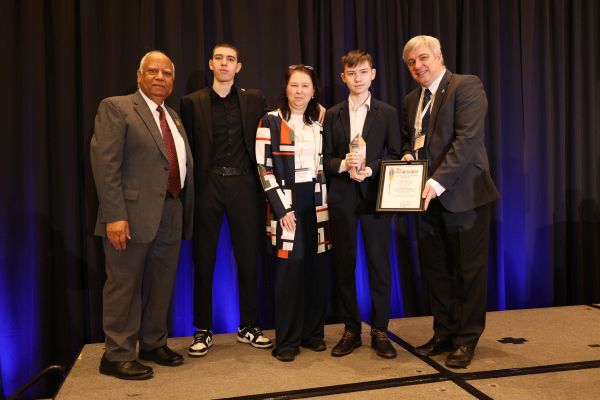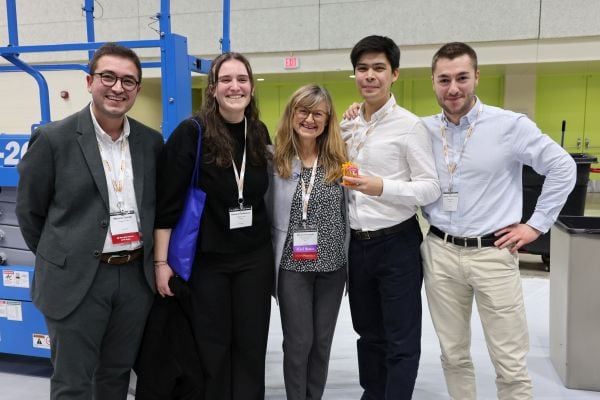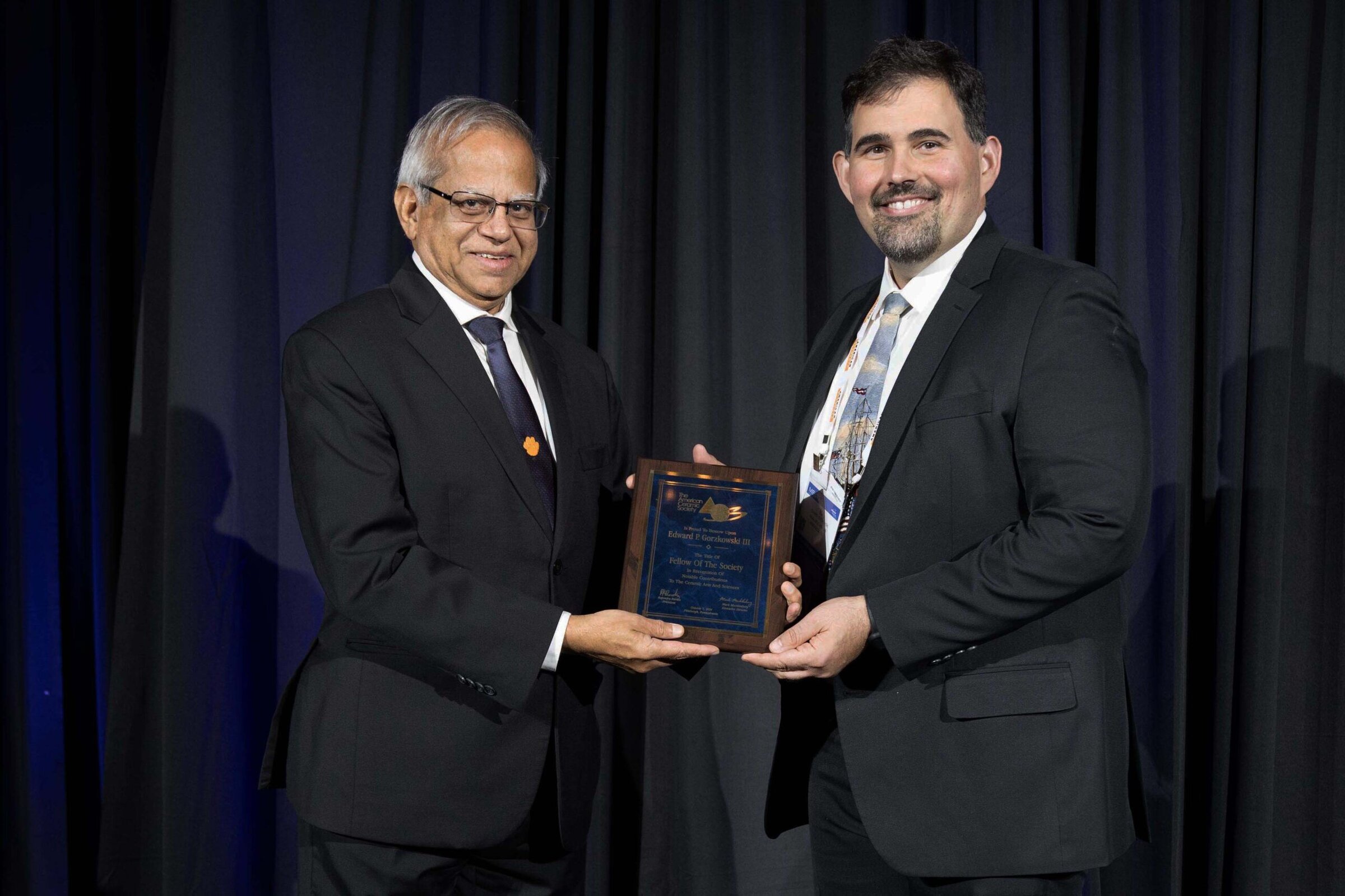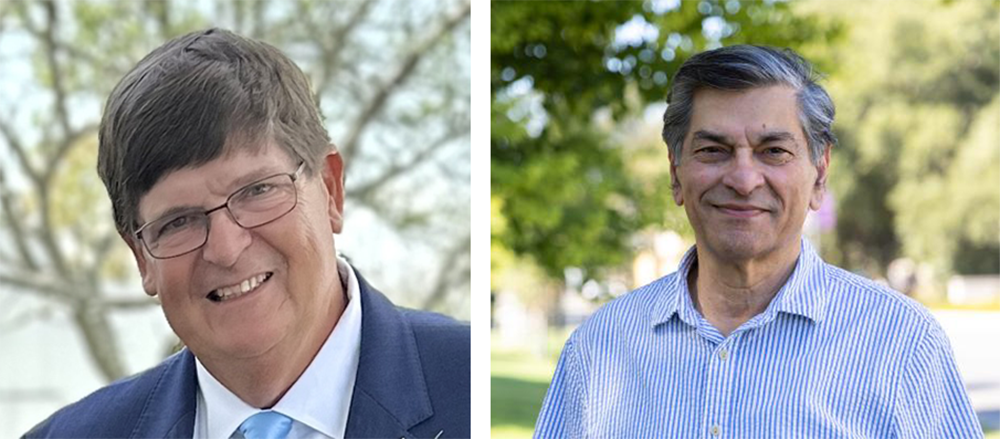
[Image above] Participants in the Conference Mentor Program at ICACC 2025. Forty attendees (20 mentors and 20 mentees) participated in the program at this conference. Credit: ACerS
Despite an unusually cold and snowy start, the 49th International Conference and Expo on Advanced Ceramics and Composites (ICACC 2025) welcomed in sunny days and sunny smiles for attendees at the Hilton Oceanfront Resort in Daytona Beach, Fla.
ICACC is the annual Division meeting organized by ACerS Engineering Ceramics Division (ECD). This year, the conference took place Jan. 26–31, 2025, and welcomed more than 900 attendees from 43 countries, including about 250 students. The concurrent expo also welcomed its best turnout since the COVID-19 pandemic, with more than 1,100 visitors coming to talk and network with the 32 exhibitors over two nights.
“ICACC 2025 successfully brought together people focusing on ceramics and composites from across the globe,” says ECD chair Jie Zhang. “I was also very happy to see all the exhibitors with their emerging products regarding the research and application of ceramics.”
ICACC 2025 program chair Amjad Almansour also praised the “great success” of ICACC 2025, saying “The great success of ICACC 2025 has demonstrated the power of scientific innovation, fostering collaboration, and sustainable pursuit of knowledge between international industry, academia and governments. These principles bring together subject matter experts, groundbreaking research, and shared vision for solving global challenges through advancing ceramics science.”
Highlights from ICACC 2025 are below.
Opening ceremony recognizes award winners and new sessions, opportunities
The conference kicked off Monday morning with the opening ceremony, where Zhang gave a warm welcome to all ICACC participants and presented several individuals with special awards.
Manisha Vidyavathy of Anna University, Wan Si Tang of the Electrochemical Safety Research Institute, and Elisa Moretti of the University of Venice were presented with the ECD’s Jubilee Global Diversity Award, and Daniel Oropeza of the University of California, Santa Barbara was presented with the 12th Global Young Investigator Award. Later that day, each recipient gave a talk about their work, which involved bioceramic additive manufacturing, battery research, nanocatalysts, and spatial tailoring of ceramics via 3D printing, respectively.
Zhang also presented five individuals with the 2025 Global Star Award, which recognizes active volunteers and their excellent contributions to the ECD and ICACC. This year’s recipients were Alberto Ortona, Hyun-Sik Kim, Ravi Kumar NV, Wei Ji, and Kamala Raghavan.
Almansour then took the stage to highlight two new focused sessions at ICACC 2025: Ceramics for Global Decarbonization, and Innovative Material Processing for Diverse Resource Circulation Loops.
He also called out a new initiative called the “Poster Preview Pitch,” which gave poster presenters the opportunity to give a 2-minute presentation on their poster, which would be on display at the expo, during a corresponding conference session. Nearly 35% of all poster presenters took advantage of this opportunity.
Award and plenary lectures explore the potential of the nano world
During the award and plenary session on Monday morning, four researchers shared insights that largely focused on the potential of nanomaterials and technology.
Subhash Risbud, Distinguished Professor in materials science and engineering at the University of California, Davis, gave the 2025 James I. Mueller Lecture. His talk focused on mullite, the “quintessential” engineered ceramic, but he used this time to thank everyone who guided him along his research journey. For example, Risbud gave a lovely introduction to James Mueller, distinguishing how influential Mueller’s advisory was on his long career in the field of ceramics.
Csaba Balazsi, scientific advisor in the HUN-REN Centre for Energy Research of Hungarian Academy of Sciences, was the 2025 Mrityunjay Singh Bridge Building awardee. He provided an in-depth discussion of nanocarbon-added ceramics, highlighting the drastic effects that graphene and carbon nanotubes can have on the thermal, mechanical, and electrical properties of ceramic materials.

This year, the ECD Bridge Building Award was renamed in honor of Mrityunjay Singh, an influential and distinguished figure in the field of engineering ceramics. Pictured is Singh (far left) with this year’s recipient of the award, Csaba Balazsi (far right), and Balazsi’s family. Credit: ACerS
Following the award lectures, the first plenary speaker, Ungyu Paik, professor in energy engineering at Hanyang University, gave an enlightening talk on how nanotechnology and energy technologies can be influenced by nanoparticle engineering. He centered his discussion around the use of nanotechnology in semiconductors as well as lithium-ion batteries, specifying state-of-the-art dry processing that can be applied in both areas of research.
Yury Gogotsi, Distinguished University Professor and Charles T. and Ruth M. Bach Endowed Chair of the Department of Materials Science and Engineering at Drexel University, spoke on how 2D ceramics will become the building blocks of the future. He captivated his audience by detailing the synthesis and applications of MXenes and the influence that he believes they will have on the scientific community in the future.
Students enjoy established and new events at ICACC 2025
Student attendees at ICACC 2025 enjoyed the return of multiple beloved conference activities in addition to several new offerings.
Among the returning activities, students participated in the longstanding Shot Glass Competition and Poster Scavenger Hunt. The President’s Council of Student Advisors (PCSA) also maintained a booth during the entirety of the conference where students could convene to network and discuss the interesting things they had learned at ICACC 2025.
“Our booth became a hub for engagement, where we connected with attendees through outreach, showcased the Ceramic and Glass Industry Foundation’s Materials Science Mini Kits, and even added a fun twist with a little bit of minigolf,” says Milos Dujovic, chair of the PCSA Conference Programming and Competitions Committee.

“Quinta nostra” was the name of this year’s winning team of the Shot Glass Competition. The team members came from the University of Limoges in France, and here they stand with ACerS president Monica Ferraris (center), who helped drop all the shot glasses during the event. Credit: ACerS
To improve their networking and professional skills, students had the opportunity to participate in ACerS’ new Conference Mentor Program, which enables new attendees to connect with long-time ACerS conference attendees. They also had the opportunity to attend a session by Ricardo Castro, editor-in-chief of the International Journal of Ceramic Science & Engineering, on how to write journal articles that engage better with your audience.
Finally, conference attendees could follow along with all the exciting activities taking place at ICACC thanks to ACerS’ new Social Media Liaisons program, which worked with student members Christine Fiedler and Francesco Bertolini to post about the conference on social media. Students interested in being Social Media Liaisons at PACRIM 16 with GOMD 2025 can email Kameron Haines at khaines@ceramics.org.
View more images from the conference on ACerS Flickr page. The Golden Jubilee Celebration of the 50th ICACC will take place Jan. 25–30, 2026, in Daytona Beach, Fla. See you next year!
Author
Madilyn Paul
Spotlight Categories
- Meeting Highlights
Divisions
- Engineering Ceramics


